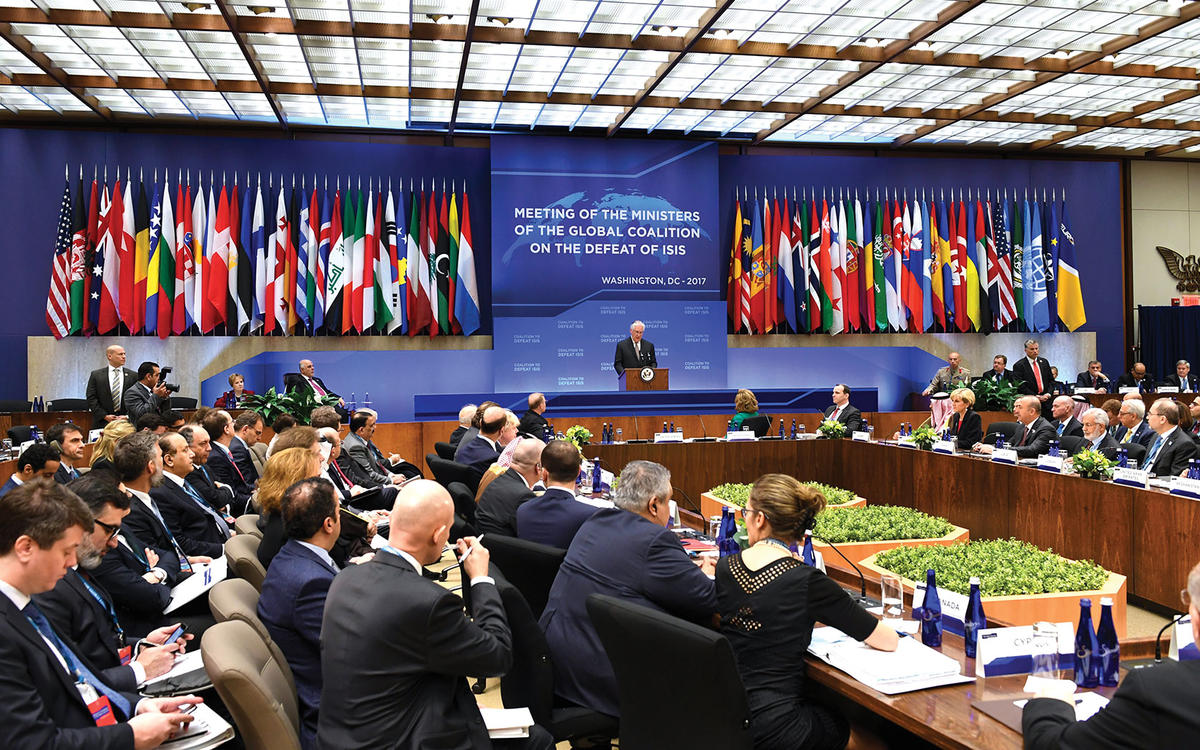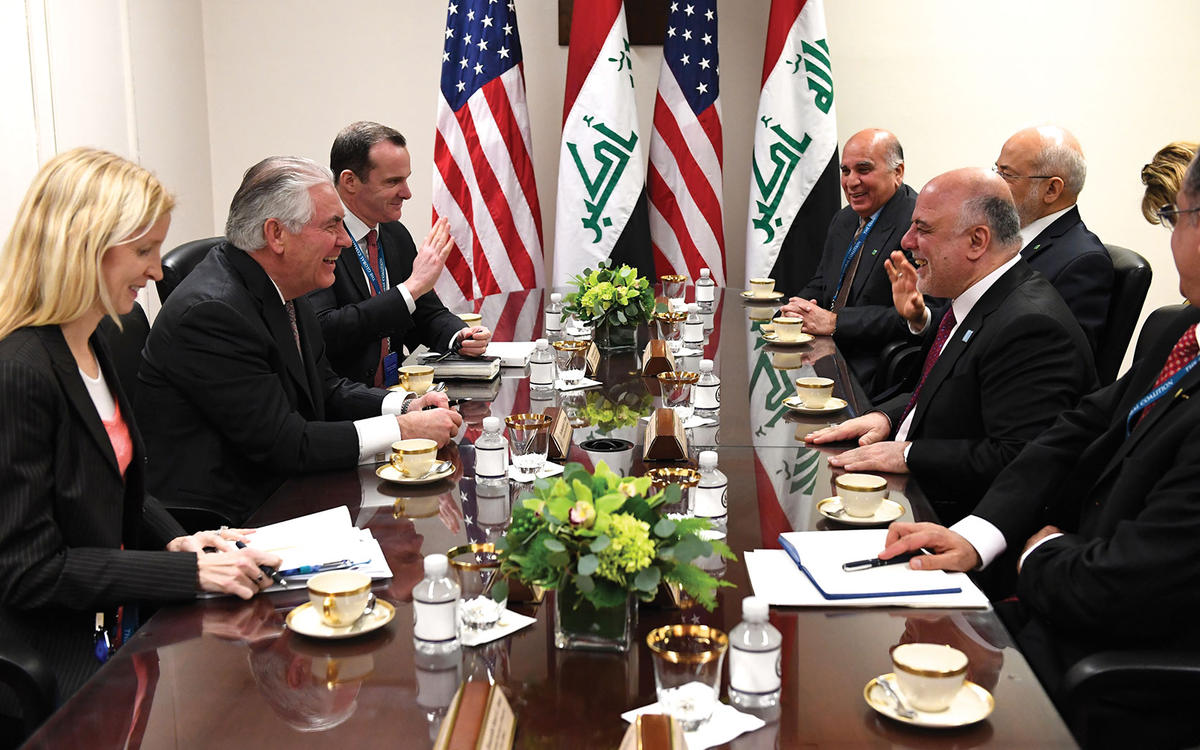The Global Coalition to Defeat ISIS: A Success Story
The 74-member international coalition illustrates American leadership in action.
BY PAMELA QUANRUD

U.S. Secretary of State Rex Tillerson delivers opening remarks at the meeting of the Ministers of the Global Coalition to Defeat ISIS at the Department of State in Washington, D.C., on March 22, 2017.
U.S. Department of State
Sometimes a truth spoken resonates so organically that it prompts a collective sigh of relief from its listeners—relief that someone has emerged from the crowd to suggest a path forward, allowing us all to shift our footing from collective outrage to collective action. That is the essence of the story behind U.S. leadership of the Global Coalition to Defeat ISIS.
During the first six months of 2014, the Islamic State of Iraq and Syria (also known as the Islamic State of Iraq and the Levant) made a dramatic debut on the world stage by capturing a wide swath of Syria and Iraq. It rolled seemingly without resistance through Fallujah, Raqqa, Tikrit and Mosul, even threatening the gates of Baghdad, before announcing the establishment of a caliphate (Islamic state) and declaring Abu Bakr al-Baghdadi as caliph—the successor to the Prophet Mohammed.
The speed of the advance, the confidence portrayed through their polished media arm, and the stories that emerged about the horrors of life under ISIS and the persecution of innocents shocked and horrified the world. In August 2014, President Barack Obama ordered air strikes to prevent the fall of the Kurdish city of Erbil and to break the group’s siege on Mount Sinjar, where thousands of ethnic Yazidis had fled after being threatened with genocide. Between Aug. 19 and Sept. 2 of that year, the world witnessed the brutal beheading of U.S. journalists James Foley and Steven Sotloff at the hands of “Jihadi John”—executions that were as carefully captured on film by ISIS media as the take of a Hollywood movie.
On Sept. 10, 2014, President Obama addressed the nation to declare that the fight against ISIS was our fight, but “not our fight alone.” American power could make a difference, he noted, but Iraq and our other partners in the region would need to be front and center in the effort. He then announced “that America will lead a broad coalition to roll back” ISIS.
The campaign would seek to “degrade, and ultimately destroy, ISIL through a comprehensive and sustained counterterrorism strategy.” This would include airstrikes and other support for forces on the ground in Iraq and Syria. The campaign would go after ISIS funding, interrupt the flow of foreign fighters into Iraq and Syria, and discredit the militants’ ideology. It would also intensify our intelligence gathering against the terrorist group and supply humanitarian assistance to those displaced by ISIS.
Concluding his address, President Obama said, “This is American leadership at its best: We stand with people who fight for their own freedom, and we rally other nations on behalf of our common security and common humanity.”
The Global Coalition Takes Shape
Two weeks later, on Sept. 24, 2014, standing before the United Nations General Assembly, President Obama reiterated that the United States was prepared to “work with a broad coalition to dismantle this network of death” and asked the world to join us. Over the next two weeks, more than 40 nations answered that call. By then, the White House had already announced the appointment of General (ret.) John Allen as the Special Presidential Envoy for the Global Coalition to Counter ISIL (now ISIS) and Deputy Assistant Secretary of State Brett McGurk as his deputy.
By the time it held its first formal meeting in Brussels two months later, the coalition had grown to 60, with member-states from North America, Asia and Europe, as well as almost a dozen from the Middle East. They committed themselves to the five lines of effort President Obama had articulated in his Sept. 10 address: the military fight; the work to stem the flow of foreign terrorist fighters; work to cut off the group’s access to funding; work to combat its toxic messaging; and provision of humanitarian assistance to the displaced (later expanded to include the stabilization of communities liberated from ISIS).
No one knew exactly what we were getting into, but the urge to stand up and be counted was strong.
Although the U.S. Central Command (CENTCOM) sought out some foreign partners for their unique capabilities or geography, the majority of the nations standing with the United States at that first ministerial meeting in Brussels had asked to be included. No one knew exactly what we were getting into, but the urge to stand up and be counted was strong. In contrast with the long, slow 1990-1991 effort in preparation for Operation Desert Shield and Desert Storm, when the United States gathered 35 nations in response to Iraq’s invasion and annexation of Kuwait, the Global Coalition to Defeat ISIS came together almost organically in those first months. In fact, the pace was so quick that it forced the State Department to enlarge the initial task force, run out of the Operations Center, into a working group to manage the outpouring of enthusiasm and contributions from partners, and eventually to turn the working group into an office.
Today coalition membership stands at 74, comprised of 70 nations and four international organizations (the European Union, North Atlantic Treaty Organization, Arab League and INTERPOL). Twenty-three partners, including the United States, have collectively stationed more than 10,000 troops in Iraq and Syria, working to build the military capacity of those engaged in direct action against ISIS and supporting efforts to deny it safe haven. The coalition has four civilian working groups, divided roughly along the lines of effort described above. More than 90 countries (including nearly two dozen observer countries) participate in a variety of meetings each quarter, depending on their interests—making this the largest international coalition in history.
While the military effort, Operation Inherent Resolve, is run by CENTCOM and its considerable machinery in Tampa, as well as through a number of forward operating bases in the region that are closer to the fight, it is important to recognize that most members of the coalition are not active in Operation Inherent Resolve. Some are battling ISIS in their own spaces, like Afghanistan or the countries of the Lake Chad Basin region. Some countries fighting ISIS are not in the coalition at all—for instance, the Philippines, which recently drove ISIS forces out of Marawi on the island of Mindanao.
Some members are not engaged in any active kinetic fighting, but are outraged that their citizens have been the victims of ISIS external operations or fear possible attacks on their homelands. Though the numbers are not precise, it is safe to say that since it appeared in 2014, ISIS has inspired or directed more than 175 attacks in more than two dozen countries, killing more than 2,300 innocent civilians; and the group increasingly claims credit for attacks even when there is no apparent connection.
Fear and moral outrage are undoubtedly strong incentives for countries to join with the United States under the banner of the coalition, but that does not explain why they stay—or why this loose collaborative effort continues to grow (as of this writing, Cameroon is the most recent country to join, in November 2017). But part of the answer may lie in how the United States runs the coalition day-to-day.

U.S. Secretary of State Rex Tillerson meets with Prime Minister of the Republic of Iraq Haider Jawad Al-Abadi in a bilateral session during the Global Coalition meeting at the Department of State on March 22, 2017. Special Presidential Envoy for the Global Coalition to Defeat ISIS Brett McGurk is at the Secretary’s left; the Secretary’s Chief of Staff Margaret Peterlin is to his right.
U.S. Department of State
The Role of U.S. Leadership
The individuals chosen to lead this coalition have had a big impact on its success. The military leadership from General Lloyd Austin and now General Joseph Votel of U.S. CENTCOM is a critical piece of the puzzle—even though most of the Global Coalition to Defeat ISIS does not participate in the military effort in Iraq and Syria. Under General (ret.) John Allen and then Brett McGurk and his deputy, Lt. General (ret.) Terry Wolff, the coalition has benefited from both visionary and talented civilian leadership.
As the first special envoy to lead the coalition, Gen. Allen breathed life into its non-military lines of effort, establishing the four working groups and recruiting 10 countries and members of the U.S. interagency community to take on the role of co-leads for these groups. The current co-leads hail from the United Kingdom, the United Arab Emirates, Italy, Saudi Arabia, the Netherlands, Turkey, Kuwait and Germany, as well as from the U.S. departments of State and Treasury.
McGurk, who took over from Gen. Allen in November 2016, brought with him a long history of fighting extremism in the region and continuous service to the cause under now three presidents. Famously, McGurk was visiting Kurdistan, in northern Iraq, when ISIS seized Mosul in 2014.
Our coalition partners have appreciated the steady leadership, regional insight and continuity McGurk and Wolff bring to the U.S. effort. The coalition has also benefited from the strong support of both President Obama and President Donald Trump. Its first-ever all-coalition ministerial meeting in March 2017 was one of the first major events Secretary of State Rex Tillerson hosted. And National Security Presidential Memorandum 3, issued on Jan. 28, 2017, calls for the “identification of new coalition partners in the fight against ISIS and policies to empower coalition partners to fight ISIS and its affiliates.”
For its part, the Global Partner team in the Office of the Special Presidential Envoy for the Global Coalition to Counter ISIS (SECI) has kept its focus on the coalition members themselves. In close coordination with country desks and U.S. embassies abroad, SECI staff work to help partners understand ISIS, follow ISIS adaptations, share best practices, support reinforcing multilateral and bilateral efforts and share insights that might help them battle ISIS or the threat of ISIS in their homelands. We try to bring about a common understanding in ways that suggest practical and timely courses of action. To help us with this work, we enjoy the support of two partner embeds on the team, from the U.K. and Germany, and look forward to welcoming a third, from Australia, soon.
A Collective Effort
Trying to keep ahead of ISIS is, of course, a collective effort. And our partners have shown remarkable leadership and initiative, both under the auspices of the coalition and on their own. The co-leads for our Communications Working Group (the U.K., U.S. and UAE) have stood up a network of messaging centers that span the globe and help countries and individuals fight back against the falsehoods ISIS so effectively delivers through its media operations.
Saudi Arabia, co-lead of the Counter-ISIS Finance Working Group, has established a multilateral Terrorist Financing Targeting Center with the support of the U.S. Treasury Department, as well as the Global Center for Combating Extremist Ideology. Italy, another co-lead, has helped shape our response to Islamic State’s looting of antiquities, and has led our efforts to train the “hold” forces that provide the first layer of the rule of law to communities liberated from ISIS.
While the military effort, Operation Inherent Resolve, is run by the U.S. Central Command, it is important to recognize that most of the coalition is not active in that aspect of the campaign.
Treasury and State have also worked together to help our military target Islamic State’s oil revenue and bulk cash sites in Iraq and Syria, to spectacular effect. Our Counter-Foreign Terrorist Fighter Working Group has benefited greatly from Dutch and U.S. efforts to cross-fertilize the work of that group with the Global Counter-Terrorism Forum and to promote information sharing through INTERPOL and other avenues.
Coalition stabilization efforts in Iraq and Syria deserve special recognition. To meet the needs of communities liberated from ISIS, the international community pioneered a new model of stabilization in partnership with the Iraqi government and the United Nations—the Funding Facility for Stabilization. This Iraqi-directed, coalition-funded, U.N.-coordinated effort has facilitated the return to their homes of more than two million Iraqis displaced by ISIS since 2014.
Stabilization Working Group co-leads Germany and the UAE have also worked closely with Washington to plan and fund early recovery work in areas liberated from ISIS in Syria, where the situation on the ground is significantly more complex than in Iraq.
The Fight Is Not Yet Over
While it may have seemed obvious in the heat of the moment back in 2014 that the United States, with its military might and its breadth of political relationships, should lead a group of countries in the fight against ISIS for three full years, it is not as obvious why so many countries would stay with us going forward. Yet our partners have said repeatedly that while they, like us, do not know exactly what lies ahead after the ISIS loss of territory (the so-called “caliphate”) in Iraq and Syria, they also do not want the coalition to end.
Looking ahead, the coalition and its leadership are at a turning point. Even as ISIS loses the last bits of its territory in Iraq and Syria, there is an ongoing need to take the group’s global ambitions seriously and monitor the evolving threat it poses.
Much depends on what happens next. If ISIS falls apart, that would vindicate those who believe that control of its “core” territory was central to the group’s existence. This may not happen. Should ISIS continue to pose a threat to both our homelands and our values, the coalition will need to adapt and perhaps even strengthen its approach. But will the coalition continue to be the central vehicle through which the nations of the world choose to maintain pressure on ISIS, or will other institutions or avenues come to the fore?
At its heart, the Global Coalition is a coalition of the willing, and it will thrive under U.S. leadership if we continue to do our best to understand the threat, share and develop that understanding with our partners, and support one another in our individual and collective efforts to defeat ISIS.








